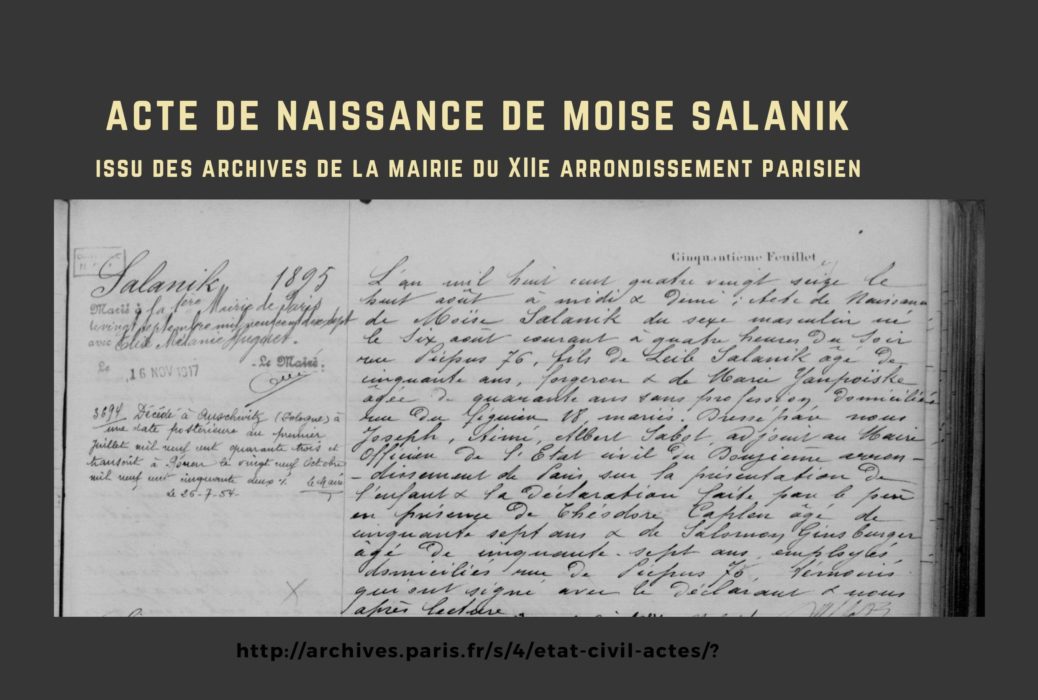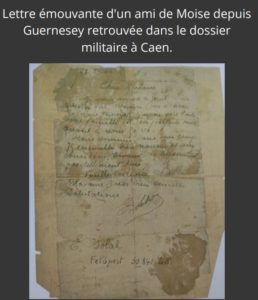Moïse SALANIK
Moïse Salanik’s childhood
Moïse Salanik was born on August 6, 1896 in the 12th district of Paris. He was the son of Leib Salanik, a blacksmith, and Marie Yanpoïske, who was not working when Moïse was born, but was a shopkeeper a few years later. The family lived at 1 bis rue du Figuier. At the time of his birth, his father was 50 years old and his mother was 40.
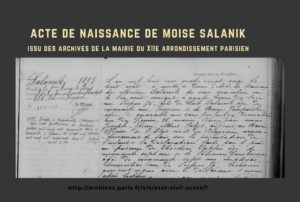
Moïse Salanik’s birth certificate, from the archives of the town hall of the 12th district of Paris.
Moïse Salanik as a young man
Moïse trained as a printer and was called up to fight in the First World War around the time of his wedding. He was 21 years old when he married Elise Mélanie Huguet on September 20, 1917 in the 1st district of Paris. His father had already passed away, but his mother was there with her family, along with the witnesses.
His wife, a cook by trade, was born on July 27, 1895. She came from a farming family in Fromental in the Haute Vienne department of France. The guests at their wedding included Max Salanik (Moïse’s brother, who lived at 1bis rue du Figuier), Léon Barchet (Moïse’s brother-in-law), David Demary (a friend of the couple) and Léonard Huguet (one of Moïse’s in-laws).
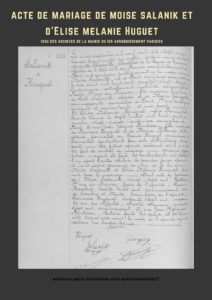
Moïse Salanik and Elise Mélanie Huguet’s marriage certificate, from the archives of the town hall of the 1st district of Paris.
Moïse’s time in Rouen
At some point, Moïse moved to an apartment at 32, rue Armand Carrel in Rouen. Some of his neighbors would later suffer the same fate as he did. One of them was Frank Gaston, who lived at n°35, as shown in the document below, which lists the Jews arrested in Rouen and transferred to Drancy. From there, the majority of them were deported to Auschwitz
Life as a Jew in Rouen during the Second World War
The persecution of the Jews began in the summer of 1940, when two new German and French laws came into force. They were both xenophobic and anti-Semitic. The Jews had to take part in a census, were put on a register, were marginalized from Rouen life and excluded from the professional and economic environment. Many examples of “Aryanization” and spoliation of Jewish property have been documented. The first of the were arrested on June 22, 1941.
From February 1942 to August 1943, further arrests of individuals and three round-ups of Jews took place in the Rouen area. Some examples of individual arrests will be described, and then the three round-ups will be discussed, including the similarities and the differences between them.
Ultimately, having had their property confiscated, and having been arrested, interned and deported, a large number of Jews from the Rouen area were murdered far from their homes.

Internment in Drancy of all the Jews of Rouen who were rounded up on January 15, 1943.

This document, signed by the prefect of the Seine Inférieure department, bears witness to the spoliation of the property of the Jews arrested in Rouen during the roundup of January 15, 1943, to the collaboration policy and to the conditions in which the Jews were transported to Drancy.
Deportation from Rouen to Auschwitz
According to the documents found in the archives in Caen, we were able to retrace the route taken by Moïse Salanik. He was arrested at 32, rue Armand Carrel in Rouen.
He spent 10 days in jail in Rouen and was then taken to Drancy on May 12, 1942.
He stayed for 3 months in Drancy and was then transferred to the Pithiviers camp on September 4, 1942.
He was transferred to Beaune la Rolande camp and then to Guernsey (a letter was mailed from there on May 28, 1944) before being deported to Auschwitz.
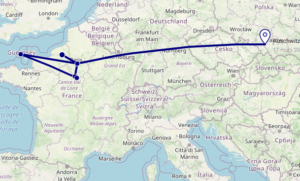
The route taken by Moïse Salanik during his deportation.
A moving letter written by one of Moïse’s friends from Guernsey, which was found in the military records in Caen.
Some facts and figures
“Rouen was one of the cities where the persecution of the Jews was the most intense”. Françoise Bottois made this bitter discovery during her research. The figures are overwhelming.
“On January 6, 1942, 264 Jews from Rouen were identified. In August 1944, 179 were murdered in the camps. That is 67%, against 24.4% for the whole of France. And the thirty young children are not included [in those figures]” says Françoise Bottois in the conclusion of her book.
At the end of her book, the historian publishes a complete list of the victims of the Shoah. We found Moïse Salanik’s name on it. According to this list, “the youngest was just two years old. His father is a survivor of the Holocaust. But his wife and three children died. He never really got over it”.
An amendment to his birth certificate
Moïse’s birth certificate states that he died in Auschwitz on a date later than July 1, 1943. (Translator’s note: In France, births are recorded in the municipality in which a child is born, and amended on marriage, divorce and death. This is called a “mention marginale”, meaning that the amendments are made in the margins of the birth certificate).
We know from the Convoy77 archives that he was among the 1310 men, women and children who were deported from Drancy in cattle cars on July 31, 1944 aboard Convoy n° 77.
His birth certificate was only amended in 1952 in Rouen, and states that he died in Auschwitz sometime after 1943.

The inscription added to Moïse Salanik’s birth certificate, from the archives of the 12th district of Paris.
A hypothetical exile route: from Salonika to Rouen, via Ukraine
Moïse Salanik was a member of the Jewish community that settled in France in the last quarter of the 19th century. There is insufficient evidence to reconstruct his family tree or the various exile routes that this family from Eastern Europe might have taken. However, other individual and collective trajectories enable us to put forward a hypothesis.
Among the lists of deportees, we find the name of Esther Barchay, née Salanik, who was born in Kiev in 1881 and died in the Lubli-Maidanek camp in Poland. We do not know if Esther and Moïse were related, but it is possible that Moïse’s paternal family also emigrated from Ukraine, as the first name of Moïse’s father, Leib, would suggest.
Going back in time
The origins of Moses Salanik’s paternal family can be traced back even further. His surname refers to the city of present-day Thessaloniki in northern Greece, or “Selânik” in Turkish. The capital of Macedonia, which is on the Aegean Sea, became home to a large number of Jews from Spain after they were driven out in 1492. This migration stream created one of the largest Jewish communities in Eastern Europe for centuries. It can be assumed that the ancestors of Moses Salanik’s family settled in Ukraine as part of a population transfer that the Ottoman authorities were renowned for in the 16th and 17th centuries.


 Français
Français Polski
Polski